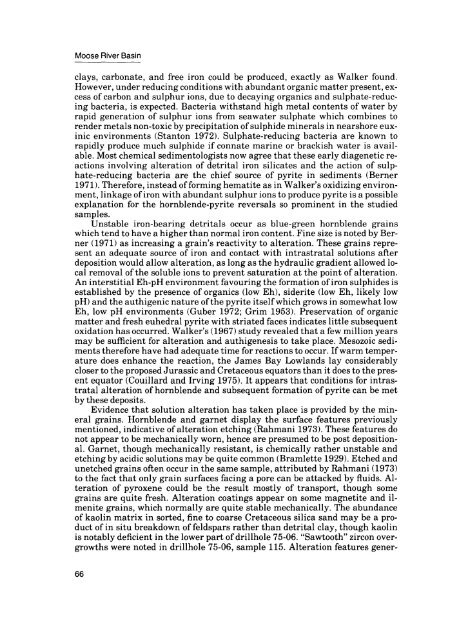Moose River Basin: geology and mineral potential - Geology Ontario
Moose River Basin: geology and mineral potential - Geology Ontario
Moose River Basin: geology and mineral potential - Geology Ontario
Create successful ePaper yourself
Turn your PDF publications into a flip-book with our unique Google optimized e-Paper software.
<strong>Moose</strong> <strong>River</strong> <strong>Basin</strong><br />
clays, carbonate, <strong>and</strong> free iron could be produced, exactly as Walker found.<br />
However, under reducing conditions with abundant organic matter present, ex<br />
cess of carbon <strong>and</strong> sulphur ions, due to decaying organics <strong>and</strong> sulphate-reduc<br />
ing bacteria, is expected. Bacteria withst<strong>and</strong> high metal contents of water by<br />
rapid generation of sulphur ions from seawater sulphate which combines to<br />
render metals non-toxic by precipitation of sulphide <strong>mineral</strong>s in nearshore eux<br />
inic environments (Stanton 1972). Sulphate-reducing bacteria are known to<br />
rapidly produce much sulphide if connate marine or brackish water is avail<br />
able. Most chemical sedimentologists now agree that these early diagenetic re<br />
actions involving alteration of detrital iron silicates <strong>and</strong> the action of sulp<br />
hate-reducing bacteria are the chief source of pyrite in sediments (Berner<br />
1971). Therefore, instead of forming hematite as in Walker's oxidizing environ<br />
ment, linkage of iron with abundant sulphur ions to produce pyrite is a possible<br />
explanation for the hornblende-pyrite reversals so prominent in the studied<br />
samples.<br />
Unstable iron-bearing detritals occur as blue-green hornblende grains<br />
which tend to have a higher than normal iron content. Fine size is noted by Ber<br />
ner (1971) as increasing a grain's reactivity to alteration. These grains repre<br />
sent an adequate source of iron <strong>and</strong> contact with intrastratal solutions after<br />
deposition would allow alteration, as long as the hydraulic gradient allowed lo<br />
cal removal of the soluble ions to prevent saturation at the point of alteration.<br />
An interstitial Eh-pH environment favouring the formation of iron sulphides is<br />
established by the presence of organics (low Eh), siderite (low Eh, likely low<br />
pH) <strong>and</strong> the authigenic nature of the pyrite itself which grows in somewhat low<br />
Eh, low pH environments (Guber 1972; Grim 1953). Preservation of organic<br />
matter <strong>and</strong> fresh euhedral pyrite with striated faces indicates little subsequent<br />
oxidation has occurred. Walker's (1967) study revealed that a few million years<br />
may be sufficient for alteration <strong>and</strong> authigenesis to take place. Mesozoic sedi<br />
ments therefore have had adequate time for reactions to occur. If warm temper<br />
ature does enhance the reaction, the James Bay Lowl<strong>and</strong>s lay considerably<br />
closer to the proposed Jurassic <strong>and</strong> Cretaceous equators than it does to the pres<br />
ent equator (Couillard <strong>and</strong> Irving 1975). It appears that conditions for intras<br />
tratal alteration of hornblende <strong>and</strong> subsequent formation of pyrite can be met<br />
by these deposits.<br />
Evidence that solution alteration has taken place is provided by the min<br />
eral grains. Hornblende <strong>and</strong> garnet display the surface features previously<br />
mentioned, indicative of alteration etching (Rahmani 1973). These features do<br />
not appear to be mechanically worn, hence are presumed to be post deposition<br />
al. Garnet, though mechanically resistant, is chemically rather unstable <strong>and</strong><br />
etching by acidic solutions may be quite common (Bramlette 1929). Etched <strong>and</strong><br />
unetched grains often occur in the same sample, attributed by Rahmani (1973)<br />
to the fact that only grain surfaces facing a pore can be attacked by fluids. Al<br />
teration of pyroxene could be the result mostly of transport, though some<br />
grains are quite fresh. Alteration coatings appear on some magnetite <strong>and</strong> il<br />
menite grains, which normally are quite stable mechanically. The abundance<br />
of kaolin matrix in sorted, fine to coarse Cretaceous silica s<strong>and</strong> may be a pro<br />
duct of in situ breakdown of feldspars rather than detrital clay, though kaolin<br />
is notably deficient in the lower part of drillhole 75-06. "Sawtooth" zircon over<br />
growths were noted in drillhole 75-06, sample 115. Alteration features gener-<br />
66

















